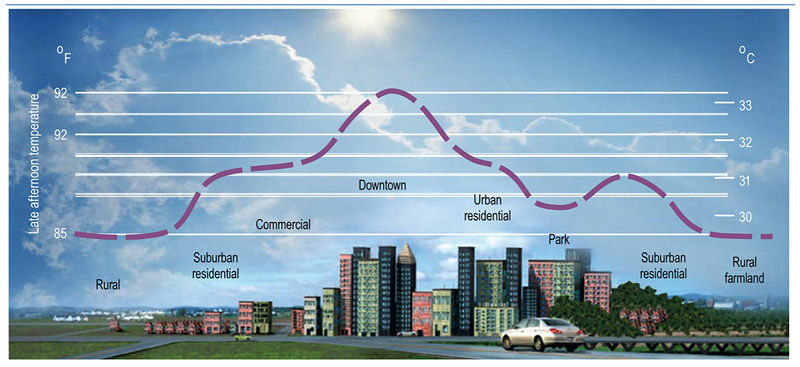PROBLEM TARGETED
Extreme climate events have considerably increased in recent years. This clearly indicates that climate change is already a reality and its impacts will most probably challenge the quality of life in our cities.
During last 15 years, the frequency and intensity of heatwaves rose in all EU, thus exacerbating other challenges, such as:
- the energy use for cooling with consequent CO2 emissions
- public health directly as well as by increasing the burden of air pollution
- the ability to work resulting in lower productivity
- the possibility to use public spaces thus constraining social life, the durability of infrastructures.
These direct and indirect impacts challenge the economy and quality of life. EU cities are projected to grow from housing nearly 73 % of the population now to more than 80% by 2050. Urban Heat Island (UHI), the phenomenon resulting in the increase of temperature in dense areas of cities in comparison with rural areas, is then exacerbating too.

The combination of these two important phenomena will result in the coming decades in ever higher temperatures inside buildings, especially in existing ones with poor energy levels. Consequently, comfort and health problems will especially occur for weak and disadvantaged groups (elderly and sick).
The intense buildings air conditioning use and the consequent Greenhouse Gases (GHG) emissions, as a consequence of cities and buildings overheating, will contribute exacerbating the climate emergency: both adaptation and mitigation strategies are needed to stop this climate “vicious circle”.
The actual buildings stock and the climate potential of renovation.
Energy demand for Air Conditioning in residential buildings is especially related to the amount of envelope surfaces directly exposed to the sun. Roofing technologies, directly exposed to sun, have a strong impact in buildings cooling needs. Currently, about 45% of the EU’s buildings are built before nineties and almost 75% of the building stock is energy inefficient, while the renovation rate of building stock is very limited. The building
construction sector is one of the EU sectors with the highest impacts on Climate. Buildings are responsible for approximately 40% of energy consumption and 36% of CO2 emissions in the EU and 84% of building heating and cooling energy demand is still generated from fossil fuels.
Therefore, renovation of existing buildings together with the design of new buildings has a great urban adaptation potential against “heat” challenge.
Many cities in Europe are already working on mitigation strategies for climate change but it is also vital and urgent to develop strategies to adapt cities to the unavoidable impacts of climate change. Vulnerability to climate change in cities is often a result of human actions such as inadequate building design or other behaviors that aggravate the impact of climate change. Urban adaptation is a systemic approach that aims to change urban design and structures, an integral part of city development and regeneration.
However, the level of awareness of adaptation still needs to be improved. Cities, especially smaller ones, often lack the capacity or resources to access knowledge and select the most appropriate tools already available.
